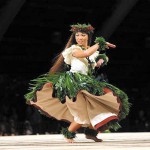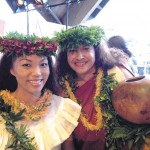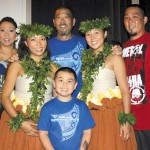Dancing For Her Queens
Nicole Ishibashi, a Waimea High alum, wowed the crowd at Merrie Monarch and placed in the top five in the Miss Aloha Hula competition, dedicating her dance to Queen Emma and Queen Kapiolani
Nicole Nalani Ishibashi’s dreams came true in 2012 when she stepped on stage at the Merrie Monarch Festival.
- Nicole Ishibashi, a Waimea High alum, wowed the crowd at Merrie Monarch and placed in the top five in the Miss Aloha Hula competition, dedicating her dance to Queen Emma and Queen Kapiolani
- Nicole Ishibashi at the beach | Coco Zickos photo
- Dancing at Merrie Monarch | Photo from Leina’ala Pavao Jardin
- With her kumu hula Leina’ala Pavao Jardin. Photo from Leina’ala Pavao Jardin
- The Ishibashi ohana (from left): mom Lisa, Nicole, dad Peter, siblings Tiffany and Brandon, and (center) nephew Kydon. Photo from Nicole Ishibashi
“I think it’s every hula girl’s dream,” she says.
The Kauai native, who is a hairstylist at Hair Razors in Lihue, had wanted to perform at the weeklong hula competition ever since she was a little girl. She’d watch it on television, begging her kumu hula, Leina’ala Pavao Jardin, to be granted an opportunity to perform.
That day finally arrived for Ishibashi two years ago when her hula halau, Ka Lei Mokihana O Leina’ala, led by Jardin, journeyed to Hawaii island and placed fourth in the Wahine Hula Auana category for their performance of Ta Pua Elama.
“For that to come true was amazing,” she says.
But it was the path it took to get there, not the result, that made her experience so sweet.
“It’s not about winning, but sharing your mele with everyone,” says Ishibashi.
Her halau returned to the festival in 2013 for Merrie Monarch’s 50th anniversary and placed third in the kahiko category for their oli (chant), Aia I Kekaha Kou Manao E.
This year, however, was groundbreaking for Ishibashi, as she placed fifth for the Miss Aloha Hula Award for her solo performance. Still, she remains humble about the prestigious honor.
“For us, it’s not really about placing; it’s about the journey,” she says. “You remember more so what we went through to get to where we are.”
Leading up to Merrie Monarch, Ishibashi put in hours of time researching her hula kahiko (ancient chant with no music), which was dedicated to Queen Kapiolani, and her hula auana (modern dance with music), dedicated to Queen Emma — two ali’i wahine who cared deeply for the Hawaiian people’s health.
When Captain Cook arrived in the Islands during the 1800s, his sailors brought diseases to which Hawaiians had not developed immunity. Both queens wanted to ensure that their people would be taken care of by encouraging them to feel comfortable with Western medicine and started their own hospitals: Kapiolani Medical Center for Women and Children and The Queen’s Medical Center.
“It amazes me,” says Ishibashi about the queens’ commitment to the Hawaiian people and how their ideas blossomed into the full-blown medical centers they are today.
Ishibashi credits her father Peter for her decision to commemorate these queens. He was diagnosed with leukemia in 2012 and currently is in remission.
“Seeing him go through that gave me a greater appreciation for Queen Emma and Queen Kapiolani for creating this legacy and these hospitals to help people,” says Ishibashi, who was born and raised in Kalaheo.
Ishibashi’s family has always been supportive of her hula endeavors. In fact, her mother Lisa, also a hula dancer, inspired her daughter to start dancing at age 5.
Coincidentally, it was the same year Jardin opened her halau in Kalaheo, where Ishibashi has been practicing and with whom she has been performing ever since.
“It really puts you in the right direction and puts you on the right path,” she says about her halau.
The discipline she received from Jardin, who has served as a second mother to her, was priceless. Not only does Jardin (who recently was awarded a Na Wahine Alakai
Women’s Leadership Award), instill Hawaiian culture in her teachings, but she also instructs her girls on how to become women, make the right choices in life and do well in school.
“Because you know if you’re bad in school, she’s going to scold you when she finds out,” jokes Ishibashi, who graduated from Waimea
High School in 2008. “She’s very involved.”
Ishibashi’s passion for hula grew throughout the years. Though she moved to Oahu to attend cosmetology school after high school, she continued taking classes each week in Kalaheo until she moved back to the island in 2012.
“We all love it; we have to love it to do it because it’s a year-round thing,” she says.
Ishibashi admits she was sad when the Merrie Monarch Festival came to a close this year. Her halau of some 30 women of all age ranges went from seeing each other every day for two weeks leading up to the competition — preparing flowers, stamping skirts and practicing — to once a week for practice.
“I didn’t realize it was over until we reached the airport here and I cried,” says Ishibashi.
She enjoys the bond they share and their mutual love for hula.
“You can have a bad day, (but) go to hula and have a beautiful night,” she says.
cocomidweek@gmail.com








